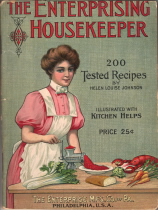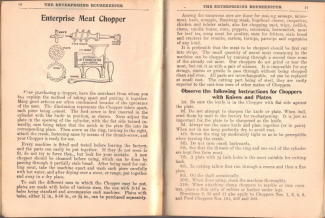 Here are pages 16 and 17 of the vintage booklet The Enterprising Housekeeper from the sixth edition (1906). If you’d like to follow along and browse through more pages of the book, I’m filing them in the Enterprising Housekeeper Category.
Here are pages 16 and 17 of the vintage booklet The Enterprising Housekeeper from the sixth edition (1906). If you’d like to follow along and browse through more pages of the book, I’m filing them in the Enterprising Housekeeper Category.
Enterprise Meat Chopper
When purchasing a chopper, have the merchant from whom you buy explain the method of taking apart and putting it together. Many good articles are often condemned because of the ignorance of the user. The illustration represents the Chopper taken apart, each piece being named. The feed screw is first inserted in the cylinder with the knife in position, as shown. Next adjust the plate in the opening of the cylinder, with the flat side turned inwardly, care being taken that the notch in the plate fits into its corresponding place. Then screw on the ring, turning to the right, attach the crank, fastening same by means of the thumb-screw, and your Chopper is ready for use.
Every machine is fitted and tested before leaving the factory, and the parts can easily be put together. If they do not seem to fit, do not try to force them, but look for your mistake. A new chopper should be cleansed before using, which can be done by passing through it partially stale bread. After being used for cutting meat, take the machine apart and wash each piece carefully with hot water, and after drying over a stove, or range, put together and away in a dry place.
To suit the different uses to which the Chopper may be put, plates are made with holes of various sizes, the one with 3-16 in. holes being standard and accompanies each machine. Plates with holes, either 1/4 in. 5-16 in., or 3/8 in., can be purchased separately.
Among the numerous uses are those for making sausage, mincemeat, hash, scrapple, Hamburg steak, hogshead cheese, croquettes, chicken and lobster salads, also for chopping suet, tripe, codfish, clams, vanilla beans, nuts, peppers, cocoanuts, horseradish, meat for beef tea, scrap meat for poultry, corn for fritters, stale bread and crackers for crumbs, carrots, turnips, parsnips and vegetables of any kind.
It is preferable that the meat to be chopped should be first cut into strips. The small quantity of uncut meat remaining in the machine can be chopped by running through a second time some of the already cut meat. Our choppers do not grind or tear the meat, but cut it as with a pair of scissors. It is impossible for any strings, sinews or gristle to pass through without being chopped clean and even. All parts are interchangeable, and can be replaced at small cost. The cutting part being of steel, they are vastly superior to the cast-iron ones of other makes of Choppers.
Observe the following Instructions for Choppers with Knives and Plates
1st. Be sure the knife is in the Chopper with flat side against the plate.
2d. Do not attempt to sharpen the knife or plate. When dull, send them by mail to the factory for re-sharpening. It is just as important for the plate to be sharpened as the knife.
3d. Always use the same knife and plate together (or in pairs). When not in use keep perfectly dry to avoid rust.
4th. Screw the ring up moderately tight so as to be perceptible when turning the crank.
5th. Do not turn crank backwards.
6th. See that the threads of the ring and one end of the cylinder are kept free from meat.
7th. A plate with 3/8 inch holes is the most suitable for cutting hash.
8th. In cutting tallow first run through a coarse and then a fine plate.
9th. Oil the shaft occasionally.
10th. When done using, clean the machine thoroughly.
11th. When attaching clamp choppers to marble or iron counters, place a thin strip of rubber or leather under legs.
Directions 9, 10 and 11 also apply to Choppers Nos. 1, 2, 4, 6 and Food Choppers Nos. 101, 202 and 303.
 More Recipes For You To Enjoy:
More Recipes For You To Enjoy:




